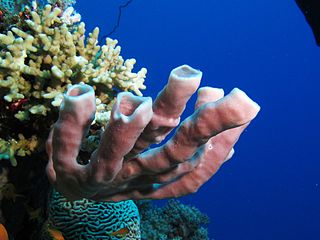Geodia gibberosa, commonly known as the white encrusting sponge, is a species of sea sponge found in the Caribbean. It is eaten by hawksbill turtles. It was first described by Lamarck in 1815.

Geodia is a genus of sea sponge belonging to the family Geodiidae. It is the type genus of its taxonomic family.

Geodiidae is a family of sea sponges.

Callyspongiidae is a family of sea sponges in the order Haplosclerida. It contains the following genera and species:

Geodia barretti is a massive deep-sea sponge species found in the boreal waters of the North Atlantic Ocean, and is fairly common on the coasts of Norway and Sweden. It is a dominant species in boreal sponge grounds. Supported by morphology and molecular data, this species is classified in the family Geodiidae.
Geodia alba is a species of sponge in the family Geodiidae. The species is found in the waters of Indonesia and was first described by Oswald Kieschnick in 1896 as Synops alba.
Geodia hirsuta is a species of sponge in the family Geodiidae. The species is found in the waters of Indonesia and was first described by Sollas in 1886 as Cydonium hirsutum.
Geodia angulata is a species of sponge in the family Geodiidae. It is found in the Pacific Ocean off the coast of California.

Geodia megastrella is a species of sponge in the family Geodiidae. It is a type of demosponge found in the deep temperate waters of the North Atlantic Ocean. It has characteristic stellar-shaped large spicules coined 'megastrellum', hence its name. The species was first described by Henry John Carter in 1876, after dredging it up aboard H.M.S. 'Porcupine', near the Cape St. Vincent in Portugal.
Geodia macandrewii is a species of sponge in the family Geodiidae. It is found in the waters of the North Atlantic Ocean. The species was first described by James Scott Bowerbank in 1858.
Geodia atlantica is a species of sponge in the family Geodiidae. It is found in the waters of the North Atlantic Ocean.
Geodia anceps is a species of sponge in the family Geodiidae. The species is found in the western part of the Mediterranean Sea and was first described by Gualtherus Carel Jacob Vosmaer in 1894 as Synops anceps.
Geodia apiarium is a species of sea sponge in the family Geodiidae. It is found in the Gulf of Mexico off the coast of Florida.
Geodia areolata is a species of sponge in the family Geodiidae. It is found in the waters of the Gulf of Mannar, between the southeastern tip of India and the west coast of Sri Lanka. The species was first described by Henry John Carter in 1880.
Geodia arripiens is a species of sponge in the family Geodiidae. It is found in the waters of the South China Sea. The species was first described by Nils Gustaf Lindgren in 1897.
Geodia conchilega is a species of sea sponge in the family Geodiidae.
Geodia nodastrella is a species of sponge in the family Geodiidae. It is found in the waters of the North Atlantic Ocean. The species was first described by Henry John Carter in 1876.
Geodia distincta is a species of sponge in the family Geodiidae. It is found in the waters of the Java Sea. The species was first described by Nils Gustaf Lindgren in 1897.
Geodia erinacea is a species of sponge in the family Geodiidae. The species was first described by Lendenfeld in 1888. It is found in all the coastal waters of Australia.

Pseudoceratina is a genus of sponge within the family Pseudoceratinidae. They are characterized by possession of a dendritic fiber skeleton lacking laminar bark but containing pith. They have been found in a variety of habitats including the Great Barrier reef, the Red Sea, and Jamaica. Sponges of this genus have a microbiome known to produce a variety of chemicals that are used in pharmaceutical and anti-fouling activities. Notably, a species in this genus produces a chemical that is effective in inhibiting the migration of metastatic breast cancer cells.



